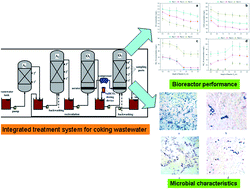Removal characteristics of organics and nitrogen in a novel four-stage biofilm integrated system for enhanced treatment of coking wastewater under different HRTs
Abstract
Coking wastewater contains substantial organics and nitrogen, posing a great threat to the water environment. In this work, organics and nitrogen removal characteristics within each single reactor of a pilot-scale four-stage biofilm anaerobic–anoxic–oxic–oxic (FB-A2/O2) coking wastewater treatment system were specifically investigated at various hydraulic retention times (HRTs). The long-term experiment showed chemical oxygen demand (COD) was greatly degraded in reactors A2 and O1, while ammonia-nitrogen (NH4+-N) was mostly removed in reactor O2. 116 h was considered to be optimum for treating coking wastewater, achieving the total COD and NH4+-N removal efficiencies of 92.3% and 97.8%, respectively. Experimental data presented good linear correlations between volumetric loading and removed loading rates among 0.15–0.65 kg COD m−3 d−1 and 0.03–0.07 kg NH4+-N m−3 d−1, much lower than treating other kinds of wastewater due to its complex composition and high toxicity. HRT also strongly influenced removal characteristics and process performance of each biofilm bioreactor. Vertical spatial distributions in DO, COD, NH4+-N and NO3−-N concentration profiles along the reactor height were obviously observed in the upflow biofilm bioreactor filled with granular media, facilitating the enhancement of organics removal, nitrification and denitrification. The FB-A2/O2 system integrated with hydrolysis-acidification, denitrification, carbonization and nitrification identified by dominant bacterial populations in each single reactor was proved to be feasible and efficient to treat poorly-degraded and highly-toxic coking wastewater.


 Please wait while we load your content...
Please wait while we load your content...